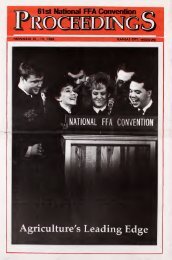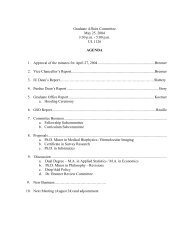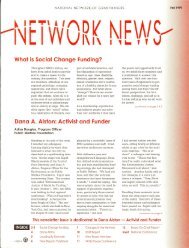FFA New Horizons
FFA New Horizons
FFA New Horizons
You also want an ePaper? Increase the reach of your titles
YUMPU automatically turns print PDFs into web optimized ePapers that Google loves.
Fruit Fly Don't Bother Me<br />
The Kohala, Hawaii <strong>FFA</strong> Chapter talces the<br />
lead in ridding the islands of this pesky—<br />
and costly—insect<br />
By Jody E. Pollok<br />
Fruit<br />
flies are a major problem in exporting<br />
fruit and vegetables from<br />
Hawaii. The female fruit flies are<br />
guilty of most of the damage done to<br />
^the fruit. After mating with the male<br />
' fly. the female goes in search of<br />
fertile ground, usually fruit, to lay her<br />
eggs. She lays about 30 eggs each<br />
time she stings the fruit. Before<br />
she is done, she will lay a total of<br />
2.000 eggs that, once hatched, will de-<br />
stroy the tropical produce.<br />
Two years ago at the Hawaii state <strong>FFA</strong><br />
convention, delegates identified this problem<br />
as one that not only hurt their agricul-<br />
tural industry, but affected the state's entire<br />
economy. The first step toward a solution<br />
to the problem came in the form of a statewide<br />
Building Our American Communi-<br />
ties (BOAC) project.<br />
The goal of the project is eliminating<br />
the female fruit fly of the three different<br />
species of fruit flies found on the islands.<br />
The climate of Hawaii supports the Medi-<br />
terranean fruit fly which came in the early<br />
1 800s. the Oriental fruit fly which came in<br />
the late 1800s and the melon fly which<br />
also arrived in the late 1800s.<br />
The Kohala <strong>FFA</strong> Chapter was the first<br />
to get involved with the project. "We de-<br />
cided to start off with the pilot project<br />
so hopefully other chapters would<br />
catch on." said chapter member Bruce<br />
Gushiken.<br />
"We chose fruit fly eradication<br />
because Hawaii wants to have a L<br />
(thriving) trade, especially in agriculture.<br />
We try to export many fruits and vege-<br />
tables such as mangos and avocados, but<br />
the fruit lly stings the fruit, infects it. thus<br />
making it undesirable and unfit for exportation,"<br />
said Gushiken.<br />
Tht 'irstStep<br />
Beginning a pi ' of this size is no<br />
easy task. "First of lu: , e organized our<br />
chapter. We discussea undertaking the<br />
32<br />
.<br />
project to see if the members<br />
were willing to give their time<br />
to the activities," Gushiken said. "We<br />
went with our chapter advisor. Mr. David<br />
Fuertes to various sessions with the University<br />
of Hawaii which has a lab on<br />
tropical agriculture."<br />
After learning about the fruit fly, the<br />
<strong>FFA</strong> demonstration team presented the<br />
information to local groups within the<br />
community and to school classrooms. In<br />
their presentations, the Kohala <strong>FFA</strong> chap-<br />
ter tries to educate<br />
community ^^^^^^^^^^_<br />
members and ele-<br />
mentary school<br />
students about the<br />
problems caused<br />
by fruit flies in<br />
Hawaii.<br />
<strong>FFA</strong> members<br />
were surprised by<br />
the response they<br />
received from<br />
community<br />
members. "They<br />
were very inspired<br />
that the<br />
younger genera-<br />
tion was so will-<br />
ing to put in theirtime to help out the com-<br />
/ munity. They were also enthusiastic<br />
because many of our community members<br />
have their own gardens where<br />
^ they raise their own fruits and vege-<br />
tables," added Gushiken.<br />
Building a Better Fly Trap<br />
Preventing the fruit from being stung<br />
by the fruit flies is challenging. <strong>FFA</strong> mem-<br />
bers from Kohala are working on traps to<br />
catch the fruit flies to limit their numbers.<br />
The traps are made of materials found<br />
around the house so that anyone can make<br />
them.<br />
Along with constructing the traps, the<br />
Kohala <strong>FFA</strong> members empty the traps<br />
The bottom line of this<br />
fruit fly eradication program<br />
is that it will open<br />
up many markets for the<br />
agricultural products<br />
that we grow but cannot<br />
be exported at this time.<br />
and tally their results. "We mark the bottles<br />
before ever distributing them. We give<br />
them different marks depending upon their<br />
location. After three weeks we collect the<br />
traps and count how many flies are in<br />
them. We compare the data from different<br />
areas to figure out where the greatest concentration<br />
of fruit flies is, " said Gushiken.<br />
The chapter continues to work with the<br />
University of Hawaii at Hilo to be aware<br />
of new technologies that are being researched<br />
for eradicating the fruit flies. As<br />
new technologies<br />
^^^^^^^^^^ are being discovered.<br />
the chapter is<br />
working to broaden<br />
the program across<br />
the entire state.<br />
Kohala <strong>FFA</strong> advisor.<br />
David Fu-<br />
ertes said, "We are<br />
hosting a workshop<br />
in which two<br />
members per chap-<br />
ter will attend to<br />
learn more about<br />
the project so they<br />
too can become involved.<br />
Wehopeto<br />
implement our program<br />
state-wide by next year."<br />
Once the eradication program takes<br />
hold throughout the state, there is ex-<br />
pected to be a drastic rise in the amount of<br />
produce exported from Hawaii. "The<br />
bottom line of this fruit fly eradication<br />
program is that if something can be done,<br />
it will open up many markets for the agri-<br />
cultural products that we grow but cannot<br />
be exported at this time." said Terence<br />
Moniz.Ka'u "<br />
.^ / <strong>FFA</strong> advisor. •••<br />
Oriental Fruit Fly (enlarged)<br />
<strong>FFA</strong> <strong>New</strong> <strong>Horizons</strong>
















